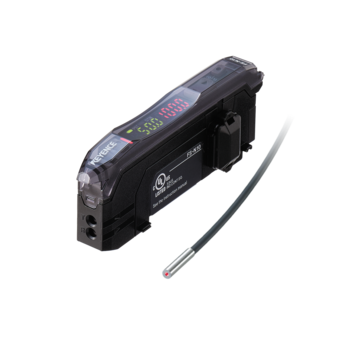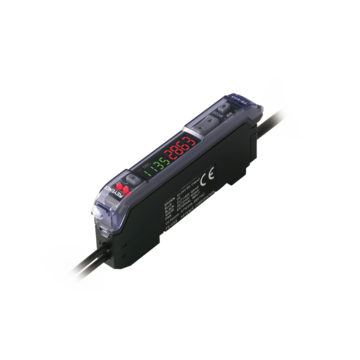Fiber Optic Sensors
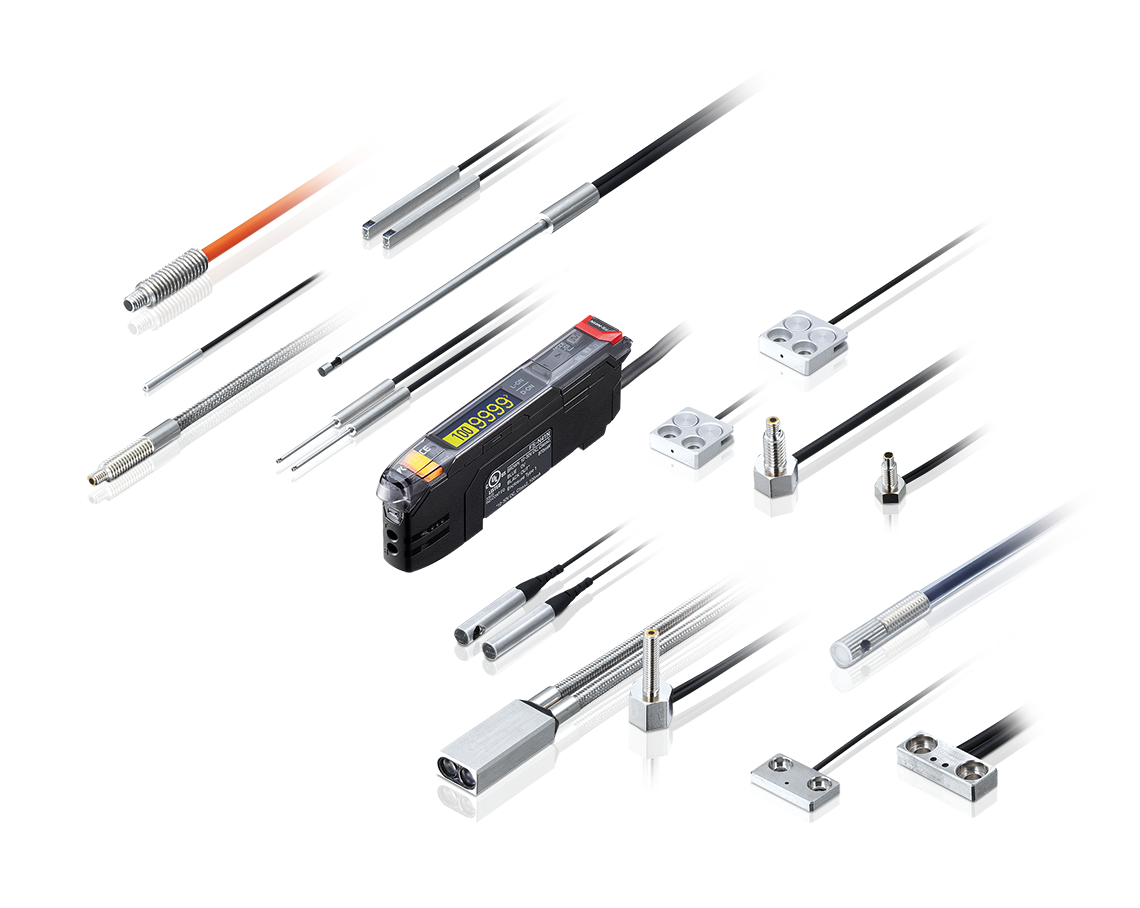
A fiberoptic sensor that uses diverse fiber units to support various applications in virtually any environment. These are reliable and easy-to-use devices that have high power, can automatically adjust to real-time conditions, and have a straightforward display that eliminates any guesswork.
Product Lineup
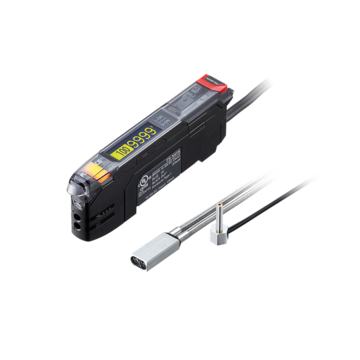
This series is able to detect virtually anything, in any environment with high power and a variety of head options. An OLED display provides clear and detailed information greatly reducing setup time. Integration is also made easy through reduced wiring options and fiber optics with integrated status indicators.
Features
Worlds Smartest Fiber Heads
Fiber optics with Built-In Indicators now allow for a quick status or alignment check by simply looking at the fiber head.
Fiber Units with Built-In Indicators
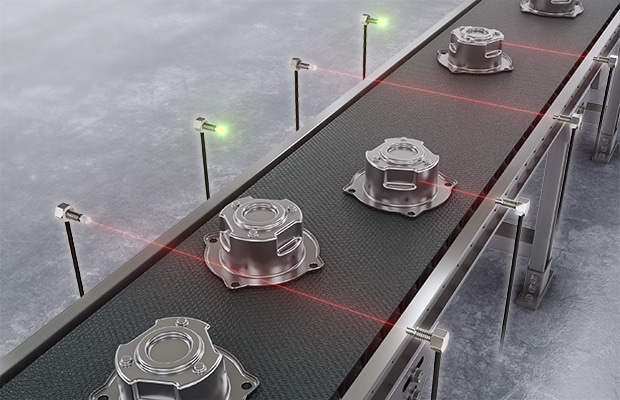
Quickly and easily recognize the sensor status by simply looking at the fiber head.
- Integrated ON/OFF status indicators
- Alignment assistance
- Easy head identification
Easy to Read OLED Display
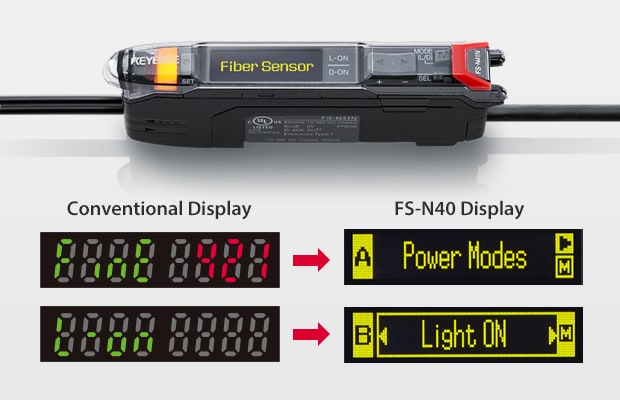
The OLED display is easy to read and the menu structure is incredibly simple, featuring intuitive navigation and easily understandable messages.
- Innovative OLED display
- Bar graph display
- Easily understandable messages
High Power and Precision
Handle any and all applications with one high-powered amplifier and a variety of head options.
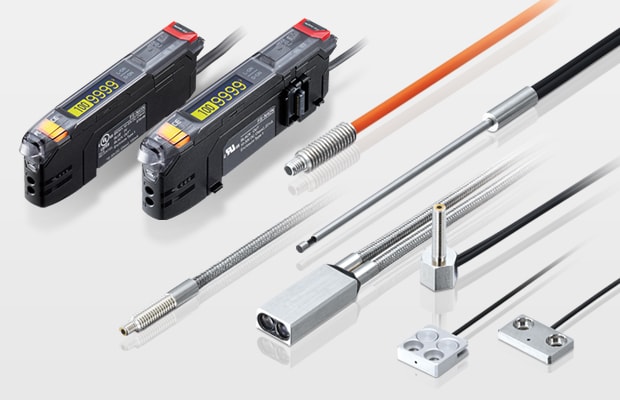
Apply Settings in 1 Second
The settings for up to 8 connected amplifiers can be saved on the Multi-Output Unit. If any of the amplifiers need to be replaced, the settings can be batch written to the new amplifiers, eliminating the need for any manual recalibration. Up to 3 memory banks can be configured to provide easy changeover between different runs on a machine.
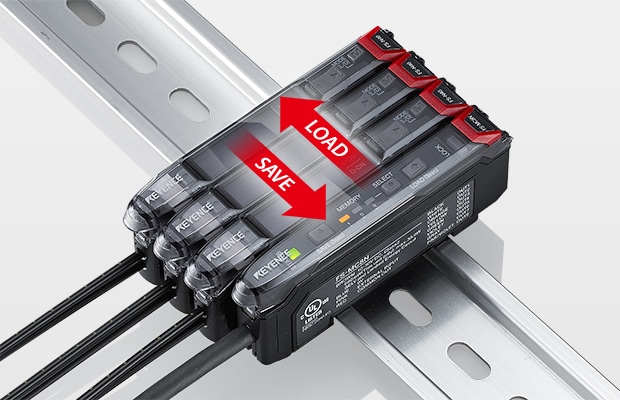
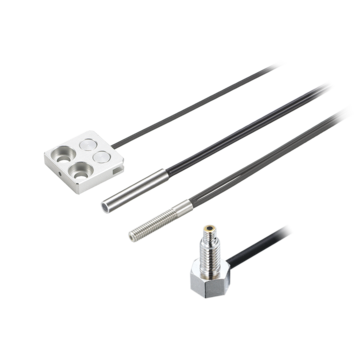
This is a series of fiber optic sensor heads designed to be connected to a fiber optic sensor amplifier. The FU Series offers a wide variety of options including thrubeam, reflective, retro-reflective and definite reflective sensing heads. Additional options include those with high environmental resistance, integrated brackets, and those designed specifically to detect difficult targets.
Features
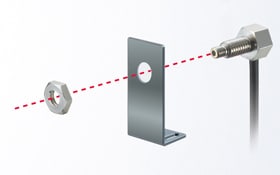
Hex-shaped Heads
Easy, trouble-free mounting. Unbreakable fiber exits the housing at a right angle, like a periscope.
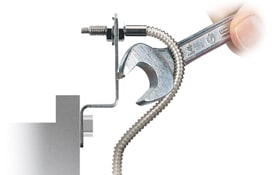
ToughFlex Heads
A flexible stainless steel jacket protects the fiber from daily wear.
A fiber optic sensor is an instrument that measures light from an LED (or other device) for detection purposes. These devices are most commonly used in factory automation environments.
Fiber optics feature two distinct components, an amplifier and sensor heads. The amplifier contains "the brains" of the sensor as well as the light source. The fiber optic cables/heads are used solely to transmit and receive the light.
Because there are no electronic components in the sensing heads, fiber optic sensors are commonly used in tight spaces, harsh environments, or simply where other sensors cannot be used.
Principles of fiberoptic sensors
Fiber optic sensors detect target conditions by transmitting light onto or across a target and measuring the increase or decrease of light returned.
Optical principles of fiberoptic sensors
The properties of light include straightness, refraction, and reflection. Fiberoptic sensors utilize these properties to enable various types of detection.
Specular reflection and retro-reflection
Specular reflection is reflection where the angle of incidence and angle of reflection of light are the same on a flat surface such as a mirror or glass. Retro-reflection is reflection where light projected at two reflective surfaces mounted at right angles is reflected off both surfaces and travels in the opposite direction of the incident light.
Refraction
Light normally travels straight through air or water. However, if the light passes through a boundary surface between materials with different refractive indices, the direction of travel changes. This phenomenon is referred to as refraction.
Polarization
Light waves normally oscillate in a variety of directions. Polarization is when oscillation is limited to one direction. Devices that restrict the oscillation direction are called polarizing filters. However, polarizing filters that restrict oscillation in a specific direction will block light with oscillation restricted in the perpendicular direction.
Detection principles of fiberoptic sensors
There are several types of fiber optic sensors. Detection methods include thrubeam, reflective, retro-reflective, and definite-reflective. Each method is used for different applications and targets.
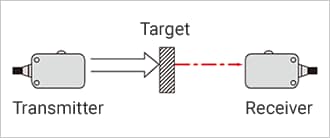
Thrubeam models
Thrubeam models include a transmitter and receiver installed opposite each other. As the target passes between the transmitter and receiver, light is blocked, and detection is performed by determining the decrease in the received light intensity. Detecting distances range from a couple inches to several feet. Stability is achieved with high resistance to dirt and dust. Opaque targets can be detected regardless of reflectance, color, or material.
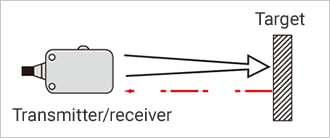
Reflective models
With reflective models, light emitted from a transmitter hits the target and the reflected light is returned to the receiver. Target detection is based on the amount of reflected light returned to the receiver. Because the detecting distances range from a couple inches to several meters, adjustment during installation is incredibly easy. Detection is possible even for small targets.
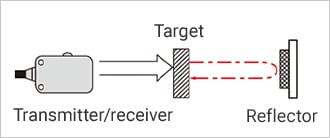
Retro-reflective models
Retro-reflective models detect the amount of light returned from a reflector installed opposite of the transmitter. The light from the reflector is blocked as a target passes through, reducing the amount of received light. Targets are detected by measuring this reduction. Installation is easy with detecting distances ranging from a couple inches to several feet. Detection is also less likely to be affected by target color or angle, and opaque targets can be detected regardless of shape, color, or material.
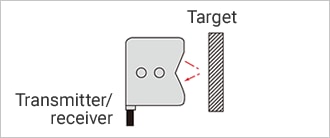
Definite-reflective models
In definite-reflective models, light is sent and received at a specific angle creating an intersecting point at a fixed distance. This ensures detection is performed only where the optical axes intersect. These models are often used when the target is relatively close and background suppression is important.
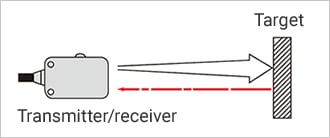
Diffuse reflective models
With diffuse reflective models, light is emitted and the target is used to reflect light back to the sensor. The transmitter and receiver or housed together, eliminating the need for a separate receiver or reflector. Any reflective target can be detected and colors can also be differentiated.
Benefits of Fiber Optic Sensors
Fiber optic sensors are compact because the detection circuit is located in the amplifier, allowing for detection even in narrow spaces. Installation and adjustment are easy and the devices have high environmental resistance—just a few of the advantages offered by fiber optic sensors.
Fiber optic heads are compact and ideal for mounting in tight spaces. Additionally, the cable connecting the fiber optic heads are highly flexible, allowing for the cable to be easily routed. For example, mounting on a robotic arm is common for fiber optics.
Also, because the fiber units do not house any electrical circuits, they are resistant to temperature, humidity, vibration, impacts, and fluids. This ensures high operation reliability even in locations where electrical noise is generated.
Most fiber optic sensors use light from an LED to detect targets, enabling detection of a wide variety of materials. This also allows for faster response times compared to other sensors.
A wide variety of target materials can be detected including metal, glass, plastic, wood, and even liquid. Stable detection is also possible for low-reflectivity target materials such as rubber and sponges. This is achieved by increasing the amount of emitted light. Some models also include a switch for adjusting the light intensity to help solve light intensity saturation problems caused by too much light. Light is emitted from the fiber unit at high speeds, and the fiber optic sensor has no moving parts, significantly reducing both operation and response times.
There are several types of detection methods with fiber optic sensors, including thrubeam, reflective, retro-reflective, and definite-reflective. Each method uses an LED or other light source for non-contact detection. This prevents damage to both the target and the sensor.
There are several types of detection methods with fiber optic sensors, including thrubeam, reflective, retro-reflective, and definite-reflective. Each method uses an LED or other light source for non-contact detection. Non-contact measurement ensures targets are not damaged while also protecting the sensor.
Some fiber optic sensors are also capable of long-range detection by increasing the power of emitted light, while still having fast response times. This range of sensing options allow users to choose the right combination to best suit their specific needs.
Fiber Optic Sensor Case Studies
Target detection in high-temperature environments
In high-temperature environments such as drying rooms, sensors with detection circuits may be damaged as the detection circuit heats up. FU Series fiber units, however, do not have detection circuits in the sensing head. Heat-resistant fiber units can handle temperatures of up to about 300°C (572°F).
The high-output FS-N40, with its newly developed NEO Parabolic LED, offers 7.5 times the received light intensity of conventional models. Meanwhile, the TERA power mode offers 220 times more power with the flick of a switch. These features enable long-range detection with no influence from heat.
Product drop detection
When using a sensor to detect the number of dropped steel balls (or something similar) the position of the targets will not be consistent. Changes in light intensity due to dust or dirt can also result in false detections. Only sudden light intensity changes caused by a passing target should be detected.
The FU-E40 Fiber Unit (FU Series) uses an area light to detect targets passing in various positions. The amplifier makes it possible to ignore gradual changes in light intensity caused by dust or dirt, ensuring that only sudden light intensity changes caused by a passing target are detected. Also, because the light is focused, this sensor can be used in crowded or tight spaces.
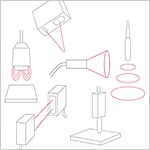
This site provides basic information to better understand sensors. Nine varieties of sensors are highlighted based on operating principle, structure, characteristics, and variations. Learn all about sensors starting from the basics.
Frequently Asked Questions About Fiber Optic Sensors
Photoelectric sensors use light to detect the presence or absence of targets. Such sensors usually use an LED as the light source and consist of two parts: a light transmitter and a light receiver. As the target passes between the transmitter and the receiver, the reflected or blocked light is converted into an electrical signal and output.
Although fiber optic sensors detect targets in basically the same way, the amplifier and the head are connected by a fiber unit. Because the amplifier that outputs the light and the transmitter and receiver are separated, these devices can be combined in various ways, so detection can be performed in various environments. The fiber unit is also incredibly thin and compact, so installation is possible in a wider variety of locations.
Detection errors are more likely when detecting small targets. Slower response speeds may also prevent detection of small, dropped targets.
To prevent such errors, select a thrubeam sensor with a small optical axis or use a slit to reduce the optical axis when detecting small targets. Doing so will stabilize detection while still providing an area large enough to capture the target.
The FU-E40 Fiber Unit (FU Series) uses an area light to detect targets passing in various positions. The amplifier makes it possible to ignore gradual changes in light intensity caused by dust or dirt, ensuring that only sudden light intensity changes caused by a passing target are detected. Also, because the light is focused, this sensor can be used in crowded or tight spaces.
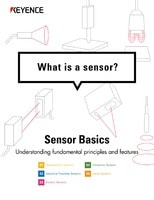
This guide includes all the information found on KEYENCE’s Sensor Basics site. Learn all about various sensors—including fiber optic sensors, photoelectric sensors, laser sensors, and contact sensors—with detailed information on measurement principles and applications. See which sensors are best suited for specific types of detection. This guide is a must-read for anyone wanting to learn more about sensors and better understand how they are best used.

Find out which sensors are most useful in the automotive industry. This guide highlights useful sensors for processes such as safety device operations, flow control, pressure control, and shape measurement.
![Sensor Applications by Series [Food/Pharmaceutical Industries]](/img/asset/AS_47064_L.jpg)
Find out which sensors are most useful in the food and pharmaceutical industries. This guide introduces useful sensors for processes such as packaging, filling, labeling, and capping.

